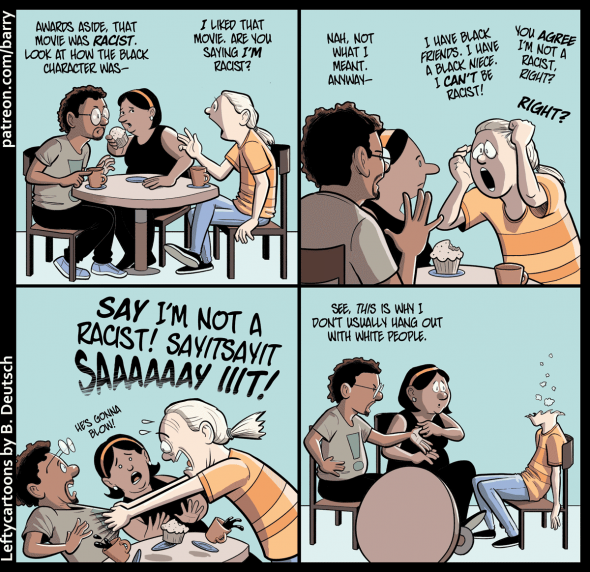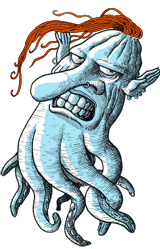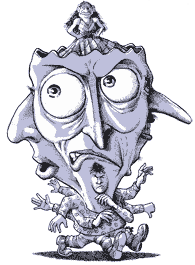
Today is National Sa’di Day, and I’ve been thinking about one of my favorite bits of verse from his Golestan:
I held in my bath a perfumed piece of clay
that came to me from a beloved’s hand.
I asked it, “Are you musk or ambergris?
Like fine wine, your smell intoxicates me.”
“I was,” it said, “a loathsome lump of clay
till someone set me down beside a rose.
Then my companion’s scent seeped into me.
Otherwise, I am only the earth that I am.
In context, Sa’di is talking about how the praise of the ruler for whom he wrote Golestan will only serve to increase the quality of the verses within the text, but these lines in particular have always conjured for me a truth about human relationships and how the “scent” of those we love inevitably seeps into us, becoming part of who we are. Lately, these lines have been making me think of the girl who was my best friend in high school: Adrienne. I don’t remember how Adrienne and I became friends, only that I very quickly came to depend on her presence in my life as part of what made living meaningful.
Like I said, I don’t remember exactly how it happened, but once we started talking, we didn’t stop, and soon I was walking or biking the few miles to her house, sometimes on Shabbos afternoons, just to hang out and sometimes to stay for dinner. I remember a narrow room with a piano and, I think, a mirror on the door, and a day bed where we sat while I poured my heart out about everything, or almost everything, that was going on in my life. I like to think that I was as good a friend to Adrienne as she was to me, but the fact is that I don’t know. I was a desperately needy kid (about which more below), and, in opening herself and her home to me (with her parents’ permission, of course), Adrienne gave me a safe space in which to be needy and to accept the succor and support of her friendship. Whether or not I gave back to her in kind, I cannot say.
When I think now about how different Adrienne and I were, it’s even more remarkable to me that we became as close as we did. Adrienne and her family lived in the next town over from mine, in a house with a manicured lawn, surrounded by other houses with similar lawns, among people who, to me, might as well have stepped out of an episode of Happy Days, except that they were middle and upper-middle class Jewish families living in the suburbs of Long Island, not the Cunninghams. I, on the other hand, was the oldest of four children being raised by a single, mother in the mid–1970s, a time when that family status still carried some significant stigma. My life outside of the yeshiva high school where Adrienne and I formed our friendship bore little resemblance to the relatively safe and privileged lives she and most of our classmates led. My friends drank and did drugs, cut school and failed classes, clashed over infractions, minor and major, with the neighborhood parents and with the cops and, in general, got themselves into (sometimes serious) trouble.
Very little of my life, in other words, fit neatly into Adrienne’s world, and very little of her life fit neatly into mine. Nonetheless, we became friends and that friendship continued after we graduated from high school and went off to different colleges. We saw each other when we could, but what I most remember were the phone conversations, one of them in particular. I was alone in my dorm room and I just felt empty. So I called Adrienne and we talked for a long time. When we were ready to hang up, I felt so much better that I said, “I love you, you know.” In my memory, I say these words with the kind of joking affection friends often use with each other, and I did not expect Adrienne to answer. To my surprise, though, she did. “I love you, too,” she said, and I could tell from her tone that she meant it, really meant it.
I was speechless. In that moment, I understood that I didn’t just love Adrienne, I was in love with her, and I wanted, I needed, for her to love me back. Every time I tried to get her to talk about it, however, she refused; and then, she met the man who is now her husband. I remember when she told me she was going to marry him. I was angry and I was jealous; I felt betrayed and I felt cheated. How could she decide that I was not the man for her without giving me a chance to be that man? I started behaving like a petulant child, refusing to ask how her fiancé was when I spoke to her, refusing to say anything more than Is Adrienne there? if he answered the phone when I called. I arrived at their wedding too late to witness the marriage vows, and I walked out of the reception less than halfway through without saying goodbye. After that, Adrienne and I didn’t speak for ten years. When we did, it was because she reached out to me in a letter she sent to the campus where I work. (She found out I worked there because one of my colleagues was a mutual acquaintance.)
We met for dinner in an Italian restaurant in Manhattan, and we talked for a long time. Eventually, of course, she asked me why I walked out of her wedding the way I did. The answer I gave was not what either of us expected, but it was a truth it had taken me ten years of not seeing her to learn. Actually, now that I think of it, there were two answers, the first one, though was to a question she didn’t ask: Why did I not make it to her wedding in time for the ceremony?
For most of the time that we were in school together, I told her, I was being sexually abused. I never told anybody, but, like most people who have been violated, I felt dirty and ashamed, unworthy of respect and, most of all, unworthy of love. Within the sphere of our friendship, however–the fact that she liked me simply for who I was, that she didn’t judge me despite the fact that we were so different–I felt clean, whole; and when she told me she loved me, I felt worthy, as if love really were something I deserved to have in my life. When she chose another man to marry, however, that rejection felt like a condemnation, proof that I did not deserve her, and if I did not deserve her, then I did not deserve anything. At least, I said, that’s how it felt back then, and so I contrived not to have to see her actually get married.
As to why I walked out, well, that was a much easier answer to give. I might not have wanted to witness her marriage, but I did want to wish her happiness, and I had come really wanting to do that. During the reception, however, whenever it looked like she was starting to head towards my table, her husband would appear at her side and guide her towards another part of the room. Or at least that’s how it seemed to me. I didn’t feel strong enough to walk up to her and say what I wanted to say, so I just got angrier and angrier each time it happened, until I couldn’t take it anymore, and I left. I told Adrienne as we waited for our food that I was sorry for having been so self-centered. She smiled and told me not to be, that I had in fact been right in thinking what I’d thought. Her husband had been quite jealous of the fact that she and I had been so close before their relationship began, and my refusal to accept him as the man she’d chosen to marry had made him feel–I wish I could remember her exact words, but it was something along the lines of “like he had to shut me out of their lives.”
It was a very sad conversation, filled with a lot of unfinished business. We might not have seen eeach other or spoken during the previous ten years, I told her, but I’d thought of her often, and, at some point, had made a promise to myself that I would dedicate my first book of poems to her. Adrienne had been the first person to believe in my writing as something worth taking seriously. As the editor of our ninth grade yearbook, she published the first poem I ever wrote, and she supported my aspirations to write through all the years of our friendship, reading and commenting on things I sent her, and even trying once to connect me through a friend of hers to the editor of an important poetry publication of the time. More than anyone else in my life at that time, Adrienne accepted my sense that writing was what kept me whole, that I had something to say, and that it was worth devoting myself to learning the craft of saying it. I might very well have become a writer even if I’d never met her, but I became the writer that I am in no small measure because the gift of her friendship helped me believe that I could. For this reason, my first book of poems, The Silence of Men is dedicated to her.
I sometimes wonder if my story with Adrienne would have a different ending if I’d waited to send her an inscribed copy of The Silence of Men rather than the book I did send her, Selections from Saadi’s Gulistan, my first published book, from which I’ve taken the two verses I quoted at the beginning of this post. Adrienne responded by writing to tell me that what she’d learned about me from this book had ended any possibility of a renewed friendship between us. “I was struck,” she wrote, “by how different our lives have become, that you have become involved in a whole different world, one so removed from my experience and knowledge. And yet I must say, it is one that I have not looked to be involved in and one that is at odds with my beliefs.” She went on to talk about how her oldest daughter was “entering the stage of meeting people who will have a profound effect on her life and her worldview or who become lifelong friends. She has met and become friends with children of my college and high school friends”–not, tellingly, our high school friends, since we had gone to high school with the same people, but her high school friends.
Clearly, in Adrienne’s eyes, I had left the world where we shared friends, where we shared a past, far, far behind, and she did not see how I could ever be a part of it again. This made me sad, but it did not surprise me. The “whole different world” Adrienne referred to was almost certainly my marriage to an Iranian Muslim woman, which I wrote a little bit about in my introduction to Gulistan, and perhaps even the realm of thought I had to enter, that of Sufi Islam, in order to make my translations in the first place. I had indeed traveled quite far from the world of the yeshiva where our friendship had begun, and I actually didn’t blame her for the way she felt about that. What truly hurt me in Adrienne’s letter was the way she tried to minimize what her friendship had meant to me. “All I ever was,” she wrote, by way of explaining that I was giving her “far too much credit” for my own development as a writer, “all I did, was be your friend and listen to you…. Please take credit for all your hard work. It is yours and, because you are a survivor, you should know that you would have achieved this no matter what.”
As if I did not know that. As if the fact of her being present for me when I needed her was not an immense thing in itself, deserving of my gratitude, even if being present was, for her, a simple and easy thing to do. As if, because I am a survivor of sexual abuse, with all the baggage that survivors bring with them, my gratitude could never be simply what I thought it was, an attempt to honor the friend Adrienne had been for me; as if it had to be, also, fundamentally, an attempt to gain her approval–which she also told me in her letter was something I should know I no longer needed–and to get from her the feeling of wholeness that I used to get when we were younger. As if the true, underyling reason I sent her my book, even if I hadn’t been aware of it at the time, had to have been to recreate the friendship we’d had in high school, before either of us ever said “I love you,” and before she fell in love with someone else and went off to build with him the life she could not see herself letting me into.
I felt, frankly, patronized and pitied. I sent Adrienne a simple note of thanks and farewell, and didn’t think much about her for a very, very long time. Then, a few days ago, I picked up my Gulistan and happened to turn to the lines I quoted above, which I will quote again here. When I finished reading, Adrienne’s was the face I saw before me:
I held in my bath a perfumed piece of clay
that came to me from a beloved’s hand.
I asked it, “Are you musk or ambergris?
Like fine wine, your smell intoxicates me.”
“I was,” it said, “a loathsome lump of clay
till someone set me down beside a rose.
Then my companion’s scent seeped into me.
Otherwise, I am only the earth that I am.
When I was in eighth grade, at a time when I thought of myself precisely as a loathsome lump of clay, life set me down beside Adrienne, and over the years of our friendship, her scent did seep into me. She did not make me who I am today; nor am I a writer because of her. My accomplishments are most definitely my own; but if I know how to be a good friend, to listen without judging, to nurture and support without an agenda, it is in large measure because I first learned from her example. I will not say I miss her. It’s been nearly thirty years since she was that kind of friend for me, and I certainly do not need her now the way I needed her then; and, as her letter showed, she either cannot or will not be that kind of friend for me again. I do wish, however, that things could have been different, or could have ended differently, between us.





 It’s been an eventful few years. Later in 2016 “The New Mother” won the Tiptree Award, came in 2nd for the Sturgeon Award, and was a Nebula nominee. In 2017 Arrate Hidalgo translated it into Spanish and it was published in Spain as
It’s been an eventful few years. Later in 2016 “The New Mother” won the Tiptree Award, came in 2nd for the Sturgeon Award, and was a Nebula nominee. In 2017 Arrate Hidalgo translated it into Spanish and it was published in Spain as 



Also, to alleviate any concerns that ICE won't arrest women and/or (probably) white people...https://www.theguardian.com/us-news/2025/jul/06/trump-voting-family-canadian-mother-detained-immigration-status